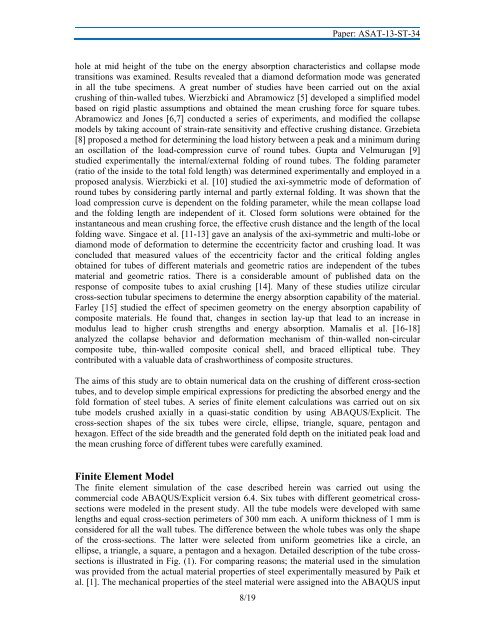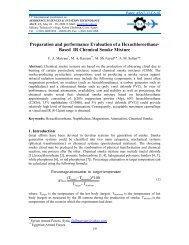Finite Element Modeling of Crushing Behaviour of Thin Tubes with ...
Finite Element Modeling of Crushing Behaviour of Thin Tubes with ...
Finite Element Modeling of Crushing Behaviour of Thin Tubes with ...
You also want an ePaper? Increase the reach of your titles
YUMPU automatically turns print PDFs into web optimized ePapers that Google loves.
8/19<br />
Paper: ASAT-13-ST-34<br />
hole at mid height <strong>of</strong> the tube on the energy absorption characteristics and collapse mode<br />
transitions was examined. Results revealed that a diamond deformation mode was generated<br />
in all the tube specimens. A great number <strong>of</strong> studies have been carried out on the axial<br />
crushing <strong>of</strong> thin-walled tubes. Wierzbicki and Abramowicz [5] developed a simplified model<br />
based on rigid plastic assumptions and obtained the mean crushing force for square tubes.<br />
Abramowicz and Jones [6,7] conducted a series <strong>of</strong> experiments, and modified the collapse<br />
models by taking account <strong>of</strong> strain-rate sensitivity and effective crushing distance. Grzebieta<br />
[8] proposed a method for determining the load history between a peak and a minimum during<br />
an oscillation <strong>of</strong> the load-compression curve <strong>of</strong> round tubes. Gupta and Velmurugan [9]<br />
studied experimentally the internal/external folding <strong>of</strong> round tubes. The folding parameter<br />
(ratio <strong>of</strong> the inside to the total fold length) was determined experimentally and employed in a<br />
proposed analysis. Wierzbicki et al. [10] studied the axi-symmetric mode <strong>of</strong> deformation <strong>of</strong><br />
round tubes by considering partly internal and partly external folding. It was shown that the<br />
load compression curve is dependent on the folding parameter, while the mean collapse load<br />
and the folding length are independent <strong>of</strong> it. Closed form solutions were obtained for the<br />
instantaneous and mean crushing force, the effective crush distance and the length <strong>of</strong> the local<br />
folding wave. Singace et al. [11-13] gave an analysis <strong>of</strong> the axi-symmetric and multi-lobe or<br />
diamond mode <strong>of</strong> deformation to determine the eccentricity factor and crushing load. It was<br />
concluded that measured values <strong>of</strong> the eccentricity factor and the critical folding angles<br />
obtained for tubes <strong>of</strong> different materials and geometric ratios are independent <strong>of</strong> the tubes<br />
material and geometric ratios. There is a considerable amount <strong>of</strong> published data on the<br />
response <strong>of</strong> composite tubes to axial crushing [14]. Many <strong>of</strong> these studies utilize circular<br />
cross-section tubular specimens to determine the energy absorption capability <strong>of</strong> the material.<br />
Farley [15] studied the effect <strong>of</strong> specimen geometry on the energy absorption capability <strong>of</strong><br />
composite materials. He found that, changes in section lay-up that lead to an increase in<br />
modulus lead to higher crush strengths and energy absorption. Mamalis et al. [16-18]<br />
analyzed the collapse behavior and deformation mechanism <strong>of</strong> thin-walled non-circular<br />
composite tube, thin-walled composite conical shell, and braced elliptical tube. They<br />
contributed <strong>with</strong> a valuable data <strong>of</strong> crashworthiness <strong>of</strong> composite structures.<br />
The aims <strong>of</strong> this study are to obtain numerical data on the crushing <strong>of</strong> different cross-section<br />
tubes, and to develop simple empirical expressions for predicting the absorbed energy and the<br />
fold formation <strong>of</strong> steel tubes. A series <strong>of</strong> finite element calculations was carried out on six<br />
tube models crushed axially in a quasi-static condition by using ABAQUS/Explicit. The<br />
cross-section shapes <strong>of</strong> the six tubes were circle, ellipse, triangle, square, pentagon and<br />
hexagon. Effect <strong>of</strong> the side breadth and the generated fold depth on the initiated peak load and<br />
the mean crushing force <strong>of</strong> different tubes were carefully examined.<br />
<strong>Finite</strong> <strong>Element</strong> Model<br />
The finite element simulation <strong>of</strong> the case described herein was carried out using the<br />
commercial code ABAQUS/Explicit version 6.4. Six tubes <strong>with</strong> different geometrical crosssections<br />
were modeled in the present study. All the tube models were developed <strong>with</strong> same<br />
lengths and equal cross-section perimeters <strong>of</strong> 300 mm each. A uniform thickness <strong>of</strong> 1 mm is<br />
considered for all the wall tubes. The difference between the whole tubes was only the shape<br />
<strong>of</strong> the cross-sections. The latter were selected from uniform geometries like a circle, an<br />
ellipse, a triangle, a square, a pentagon and a hexagon. Detailed description <strong>of</strong> the tube crosssections<br />
is illustrated in Fig. (1). For comparing reasons; the material used in the simulation<br />
was provided from the actual material properties <strong>of</strong> steel experimentally measured by Paik et<br />
al. [1]. The mechanical properties <strong>of</strong> the steel material were assigned into the ABAQUS input





